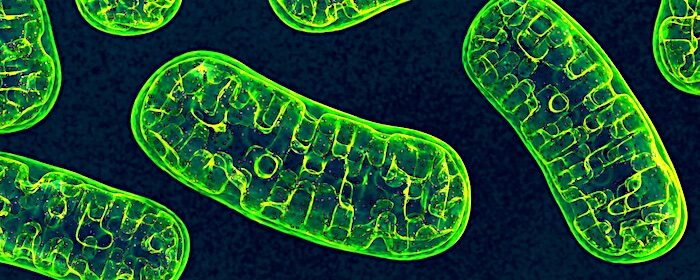In a creative feat of molecular engineering, scientists have for the first time developed a gene editing tool capable of making targeted, single base pair changes in the DNA of mitochondria. The new editor, derived from a bacterial toxin, could allow researchers to better study mitochondrial diseases ahead of possible future treatments, Science reports.
While genome editing tools such as CRISPR can easily enter the nucleus of a cell, the mitochondria are swathed in membranes, making them inaccessible to bulky CRISPR molecules. Other tools such as TALENs and ZFNs have previously passed into the mitochondria of plant and animal cells, but STAT reports that these early tools were only able to cut out and remove mutated DNA, not correct it with targeted precision. Because of the difficulty in rewriting mitochondrial DNA, scientists have struggled to create animal models of mitochondrial diseases with the same mutations to study them in detail.
Fyodor Urnov, a biologist at the Innovative Genomics Institute, who reviewed the team's July 8 paper in Nature, tells STAT.
"We've been looking for a technology like this for a very long time. We've been able to make point mutations in human nuclear DNA for 15 years, but mitochondria have resisted that furiously, much to the great frustration of everybody. With this technology, mitochondrial research will enter a golden age."Mitochondria do a lot with their relatively paltry 37 genes — compared to around 30,000 in the nuclear human genome — generating the chemical energy that drives normal cellular function and synthesizing important hormones and neurotransmitters. Even a single base pair change in many of these genes can lead to devastating, and often deadly, diseases, STAT reports.
Mitochondrial diseases often begin manifesting from birth. The most common mitochondrial disease, mitochondrial encephalomyopathy, lactic acidosis, and stroke-like episodes (MELAS), causes repeated seizures in young children and can stem from a single nucleotide change in the MT-TL1 gene that slows protein production. Another mitochondrial disease, mitochondrial DNA depletion syndrome (MDDS), attacks the muscles and brain as a result of single point mutations across multiple genes.
David Liu, a chemical biologist at the Broad Institute who coauthored the paper, has been working to develop gene editing tools called base editors, capable of swapping one pair of nucleotides for another.
Across the country, Joseph Mougous, a biologist at the University of Washington, was studying the weapons bacteria use to fight each other. One day, he tells STAT, his postdoc Marcos de Moraes isolated a toxin secreted by the bacterium Burkholderia cenocepacia to infiltrate and kill other competing strains. In targeting certain areas along a rival bacterium's DNA, the toxic enzymes prompted single letter changes — converting a C to a T — that caused the DNA to degrade.
Mougous reached out to Liu to ask if this bacterial toxin might have use as a base editor. Liu's own pioneering CRISPR tools only work on single stranded DNA, Science reports, relying on the Cas9 enzyme to split the DNA into two single strands for the editing enzymes to act on. But the new method can make single nucleotide changes directly on double-stranded DNA, and because it doesn't rely on a bulky guiding strand of RNA to direct the Cas9 enzyme, it's able to pass into mitochondria.
While it sounded promising in theory, Mougous was still suggesting they inject a toxin into human cells — in a worst-case scenario, the enzyme might cause massive damage. Liu asked him how he planned to "tame the beast." A graduate student in Liu's lab, Beverly Mok, came up with the idea of splitting the enzyme into two nonreactive pieces and attaching them to proteins that bind specifically to the target site in the mitochondrial genome. Once both pieces are present, they could be rejoined, jumpstarting the repair process.
In studies using human cells, the tool effectively repaired between 20 percent to 40 percent of its targets after three to six days, STAT reports. And while Mok's method of splitting the enzyme in two seemed to keep the process in check, there were some off-target edits. Nevertheless, the findings have the potential to push mitochondrial research into a new phase.
"I've been in the field for 25 years, and this is the first time ever that we've been able to [manipulate cells], and, voilà, a few days later, you have edits to the mitochondrial DNA," Vamsi Mootha, a Broad Institute specialist in mitochondrial dysfunction and coauthor, tells Science.
It will likely be years, if not decades, before any person can be treated with therapeutics based on the new method. Even then, doctors would need to catch the diseases early enough in children to successfully minimize damage to the brain and muscles, STAT reports. "There is room for improvement," Urnov says, "but the history of this field tells us that something that starts at 20% efficiency can, with technical optimization, get to 80% and above."
In the short term, Michal Minczuk, a mitochondrial geneticist at the University of Cambridge who was not involved in the work, tells Nature, the toxin may help to generate animal models that would allow researchers to study mitochondrial abnormalities in more detail. "We could expedite this tremendously," he says. "It's an amazing step forward."




R.C.